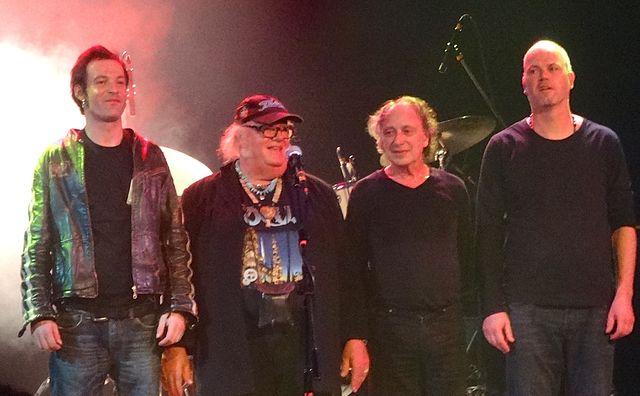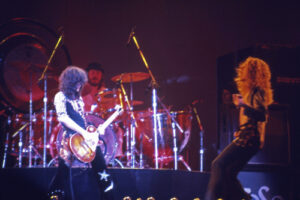# 10 – I Want the One I Can’t Have – The Smiths
“I Want the One I Can’t Have” by The Smiths is a standout track from Meat Is Murder, their second studio album, released in 1985. The song epitomizes the themes of unrequited love and desire, which are common in The Smiths’ music. In this song, Morrissey, with his melancholic and emotive vocal delivery, conveys a yearning for someone out of reach. The frustration of wanting someone you can’t have is captured in the repeated lyric “It’s driving me mad,” which is layered over Johnny Marr’s jangly, upbeat guitar riff. The contrast between the upbeat instrumentals and the darker lyrical content adds complexity to the song’s emotional pull, making it a quintessential Smiths track.
Recorded in the autumn of 1984, Meat Is Murder was produced by The Smiths themselves alongside Stephen Street. The album was recorded primarily at Amazon Studios in Liverpool and Ridge Farm Studio in Surrey. The song features Morrissey on vocals, Johnny Marr on guitar, Andy Rourke on bass, and Mike Joyce on drums. “I Want the One I Can’t Have” fits seamlessly within the album’s soundscape, characterized by Marr’s distinctive guitar work and Morrissey’s introspective lyricism. The track’s mix of post-punk and indie rock styles captures the essence of 1980s alternative music while maintaining the emotional depth that would come to define The Smiths’ legacy.
This track sets the tone for the rest of this list, encapsulating the frustration and emotional complexity of wanting someone who remains out of reach. With its memorable chorus and Morrissey’s iconic lyricism, “I Want the One I Can’t Have” is an essential song about obsession, desire, and the unattainable, paving the way for more explorations into similar themes by other artists.
Read More: Our 10 Favorite Smiths Songs
# 9 – I Want You Around – The Ramones
The Ramones’ song “I Want You Around” is a significant track from the Rock ‘n’ Roll High School soundtrack, a 1979 movie that prominently features the band both musically and in cameo roles. The song, written by Joey Ramone, delves into the familiar Ramones territory of youthful yearning, expressing the frustrations of wanting someone who might be just out of reach. Its inclusion in the film ties directly into the movie’s rebellious spirit and themes of teenage desire and defiance, perfectly capturing the Ramones’ punk ethos.
Though “I Want You Around” wasn’t a chart-topping hit, its inclusion in Rock ‘n’ Roll High School secured its place in Ramones history. The film became a cult classic, and so did the song, resonating with fans who found themselves in similar situations of wanting someone but being unable to have them. The Ramones’ ability to package those emotions into short, punchy songs became a hallmark of their career. The track itself stands out as a unique blend of the band’s punk rock roots and their ability to craft relatable love songs, making it an enduring favorite in the Ramones’ catalog.
Read More: Complete List Of Ramones Albums And Songs
# 8 – To Be With You – Mr. Big
“To Be with You” is an iconic soft rock ballad by American rock band Mr. Big, released as the second single from their 1991 album Lean into It. Written by lead vocalist Eric Martin and David Grahame, the song became Mr. Big’s most successful single, topping the Billboard Hot 100 for three weeks and charting at number one in eleven other countries. The track was recorded at Rumbo Studios in Los Angeles and Cherokee Studios in Hollywood, with Kevin Elson as the producer, shaping it into a timeless hit that defined the band’s career.
Read More: Paul Gilbert of Mr. Big Interview: 10 Albums That Changed My Life
# 7 – Fade Away – Bruce Springsteen
“Fade Away” is a deeply emotional ballad by Bruce Springsteen, released in 1980 on The River, his fifth studio album. The River was recorded at The Power Station in New York City, with production led by Springsteen, Jon Landau, and Steven Van Zandt. “Fade Away,” one of the standout tracks on the album, captures the heartache and frustration of wanting someone who is slipping away. Released as a single in 1981, it reached number 20 on the Billboard Hot 100, further solidifying Springsteen’s status as a master of narrative-driven songwriting.
Read More: Best Songs Bruce Springsteen Wrote For Southside Johnny
# 6 – Heartbeat – The Runaways
“Heartbeat” is a track from Queens of Noise, the second studio album by American rock band The Runaways, released on January 7, 1977, through Mercury Records. The Runaways were pioneers in the all-female rock band scene, and Queens of Noise further solidified their place in rock history with its powerful blend of punk, glam, and hard rock. Recorded in the midst of the band’s rise to fame, Queens of Noise was produced by Earle Mankey, with the album being recorded in Los Angeles in 1976. Featuring Cherie Currie on lead vocals, Joan Jett on rhythm guitar, Lita Ford on lead guitar, Jackie Fox on bass, and Sandy West on drums, the album showcased the raw energy and rebellious spirit that made The Runaways a trailblazing act.
# 5 – I May Not Be Your Kind – Garland Jeffreys
“I May Not Be Your Kind” is a standout track from Ghost Writer, the second solo album by Garland Jeffreys, released in 1977. The album, recorded with an impressive roster of session musicians, showcases Jeffreys’ blend of rock, reggae, and soul, and his ability to explore complex social and personal themes with subtlety and insight. Ghost Writer was recorded at A&R Studios in New York City, with Jeffreys producing alongside Roy Cicala. Musicians such as Dr. John, The Brecker Brothers, and Steve Gadd contributed to the album’s sound, cementing Jeffreys’ reputation as a versatile and socially-conscious artist.
Ghost Writer peaked at No. 140 on the Billboard 200, and though it didn’t reach major commercial success, it has since gained critical recognition as one of Jeffreys’ finest works. “I May Not Be Your Kind” remains a key track, showcasing his lyrical depth and ability to address difficult topics through the lens of deeply personal emotions.
Read More: How ‘Ghost Writer’ Turned Us On To The Music Of Garland Jeffreys
# 4 – Wedding Bell Blues – Laura Nyro
“Wedding Bell Blues,” written and recorded by Laura Nyro in 1966, tells the story of a woman deeply in love with her boyfriend but frustrated by his reluctance to propose. The song’s title became a popular phrase in American culture, representing the longing for marriage that many people experience when a relationship stalls short of commitment. The track was part of Nyro’s debut album More Than a New Discovery, which was released through Verve Folkways. However, the song gained widespread fame with the 5th Dimension’s 1969 cover, which reached number one on the Billboard Hot 100 chart.
Nyro originally wrote the song at the age of eighteen, and its lyrics reflect both adoring love and frustrated lament. The song’s narrator, using the name “Bill” to address her lover, questions whether she will ever “see her wedding day” and pleads for a deeper commitment. The song is a “mini-suite,” featuring multiple shifts in rhythm and tempo, a hallmark of Nyro’s distinctive songwriting style. However, the original recording saw Nyro’s creative vision compromised, as arranger Herb Bernstein didn’t allow her to record the version she had envisioned, which led to some personal dissatisfaction on her part. Despite this, Nyro’s passionate and soulful vocal performance shines through, particularly in lines like, “Bill, I love you so, I always will,” underscoring the intensity of her longing.
Although the song only reached No. 103 on Billboard’s “Bubbling Under” chart in its original release, “Wedding Bell Blues” gained significant attention when it was covered by the 5th Dimension in 1969. Their version achieved a more polished, radio-friendly sound, and became a major hit. Nyro’s original recording, in contrast, carried a more raw and soulful tone, reflecting her emotional depth and unique arrangement style. The song’s success with the 5th Dimension helped bring greater attention to Nyro’s songwriting talents and cemented her status as an influential artist in the 1960s and 1970s.
Read More: Top 10 Laura Nyro Songs
# 3 – Love On The Phone – Suzanne Fellini
“Love On The Phone” by Suzanne Fellini, from her self-titled album Suzanne Fellini, released in 1980, offers a poignant look at desire and longing through the lens of a distant relationship. Casablanca Records, which released the album, was best known for its diverse roster of artists, from disco sensation Donna Summer to rockers like Kiss. Suzanne Fellini’s single represents a unique blend of rock and pop, offering a reflection on how distance can intensify yearning, especially in romantic relationships that rely on technology to keep the connection alive. The song’s release in 1980 places it squarely in an era when telephone communication was a lifeline for long-distance lovers, further heightening its emotional impact.
Read More: In 1980 Suzanne Fellini Released Love On The Phone Then Disappeared
# 3 – If Loving You Is Wrong (I Don’t Wanna Be Right) – Rod Stewart
Rod Stewart’s cover of “If Loving You Is Wrong (I Don’t Wanna Be Right)” offers a powerful rendition of a classic soul track that explores the complexities of forbidden love and the emotional turmoil that comes with it. Originally written by Homer Banks, Carl Hampton, and Raymond Jackson, and first popularized by Luther Ingram in 1972, Stewart included his own version of the song on his 1977 album Foot Loose & Fancy Free. The album, which marked Stewart’s transition from his early rock sound into more pop-oriented material, showcases his ability to bring a raw, emotional delivery to a track that deals with complicated themes of morality, love, and guilt.
Read More: Top 10 Rocking Rod Stewart Songs From The 1970s
# 2 – Love The One You’re With – Stephen Stills
Stephen Stills’ “Love the One You’re With” is a landmark song in the folk rock genre and stands as his biggest solo hit. Released in November 1970 as the lead single from his debut solo album Stephen Stills, the song quickly gained popularity, reaching No. 14 on the Billboard Hot 100 in early 1971. The song was inspired by a line Stills heard from fellow musician Billy Preston: “If you can’t be with the one you love, love the one you’re with.” This phrase would go on to become the foundation for a song that captures a carefree, ‘seize-the-moment’ attitude. The song’s lighthearted, easygoing message resonated with audiences at the time, contributing to its chart success and cultural impact.
Read More: 10 Essential Stephen Stills Songs In Chronological Order
# 1 – Layla – Derek & The Dominoes
As the closing track on this list of 10 Rock Songs About Wanting Someone You Can’t Have, “Layla” by Derek and the Dominos stands as one of the most iconic songs in rock history. Written by Eric Clapton and Jim Gordon and released in 1970 on the album Layla and Other Assorted Love Songs, the song epitomizes the anguish and obsession that comes with unrequited love. The inspiration behind “Layla” is as legendary as the song itself, drawing from both ancient Persian literature and Clapton’s real-life infatuation with Pattie Boyd, the wife of his close friend and fellow musician George Harrison. Clapton’s pained yearning is evident in every lyric, transforming the song into a profound expression of desire and emotional torment.
The recording of “Layla” took place at Criteria Studios in Miami between August and September of 1970, with Tom Dowd as producer. The song features contributions from an all-star lineup, including Clapton on lead guitar and vocals, Jim Gordon on drums, Bobby Whitlock on keyboards and vocals, and Carl Radle on bass. Duane Allman of the Allman Brothers Band also played a pivotal role, adding the iconic slide guitar riff that drives the first part of the song. This collaboration between Clapton and Allman is often regarded as one of the greatest guitar pairings in rock history. The song’s structure is divided into two distinct sections: the first, a fast-paced, bluesy rock anthem driven by Clapton’s plea for love; the second, a slower, melancholic piano coda that Jim Gordon composed, although it has been debated that Rita Coolidge, Gordon’s girlfriend at the time, also contributed to the piano section.
“Layla” was initially released in 1971 but did not become a major hit until 1972, when it reached number 10 on the Billboard Hot 100 in the U.S. and number seven in the U.K. A second, acoustic version of the song, released on Clapton’s Unplugged album in 1992, achieved even greater commercial success, winning the Grammy Award for Best Rock Song in 1993. Both versions of the song remain iconic, with the original electric version widely regarded as one of the greatest rock songs of all time.
As the final song on this list, “Layla” represents the ultimate expression of unattainable love. Its blend of powerful guitar riffs, soul-baring lyrics, and emotional depth makes it a fitting conclusion to this exploration of rock songs about obsession and desire. Few songs in rock history so perfectly encapsulate the turmoil of wanting someone you cannot have, cementing “Layla” as a timeless classic that resonates with listeners across generations.




































